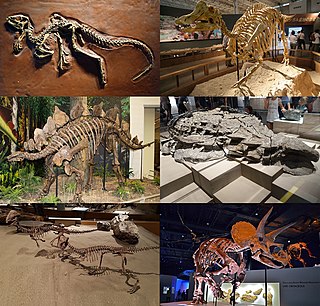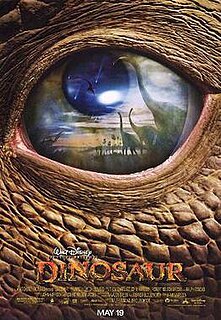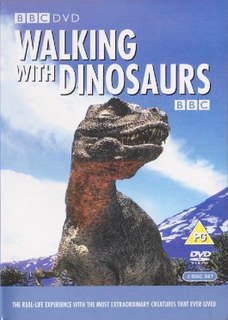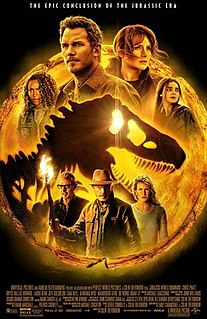| Steropoides | |
|---|---|
| Trace fossil classification | |
| Kingdom: | Animalia |
| Phylum: | Chordata |
| Class: | Mammalia |
| Ichnogenus: | † Steropoides Hitchcock, 1845 |
Steropoides is an ichnogenus of Prehistoric mammal footprint.
| Steropoides | |
|---|---|
| Trace fossil classification | |
| Kingdom: | Animalia |
| Phylum: | Chordata |
| Class: | Mammalia |
| Ichnogenus: | † Steropoides Hitchcock, 1845 |
Steropoides is an ichnogenus of Prehistoric mammal footprint.

Allosaurus is a genus of large carnosaurian theropod dinosaur that lived 155 to 145 million years ago during the Late Jurassic epoch. The name "Allosaurus" means "different lizard" alluding to its unique concave vertebrae. It is derived from the Greek ἄλλος and σαῦρος. The first fossil remains that could definitively be ascribed to this genus were described in 1877 by paleontologist Othniel Charles Marsh. As one of the first well-known theropod dinosaurs, it has long attracted attention outside of paleontological circles.

Dinosaurs are a diverse group of reptiles of the clade Dinosauria. They first appeared during the Triassic period, between 243 and 233.23 million years ago (mya), although the exact origin and timing of the evolution of dinosaurs is the subject of active research. They became the dominant terrestrial vertebrates after the Triassic–Jurassic extinction event 201.3 mya; their dominance continued throughout the Jurassic and Cretaceous periods. The fossil record shows that birds are feathered dinosaurs, having evolved from earlier theropods during the Late Jurassic epoch, and are the only dinosaur lineage known to have survived the Cretaceous–Paleogene extinction event approximately 66 mya. Dinosaurs can therefore be divided into avian dinosaurs—birds—and the extinct non-avian dinosaurs, which are all dinosaurs other than birds.

Tyrannosaurus is a genus of large theropod dinosaur. The species Tyrannosaurus rex, often called T. rex or colloquially T-Rex, is one of the best represented theropods. Tyrannosaurus lived throughout what is now western North America, on what was then an island continent known as Laramidia. Tyrannosaurus had a much wider range than other tyrannosaurids. Fossils are found in a variety of rock formations dating to the Maastrichtian age of the Upper Cretaceous period, 68 to 66 million years ago. It was the last known member of the tyrannosaurids and among the last non-avian dinosaurs to exist before the Cretaceous–Paleogene extinction event.

Triceratops is a genus of herbivorous chasmosaurine ceratopsid dinosaur that first appeared during the late Maastrichtian stage of the Late Cretaceous period, about 68 million years ago in what is now North America. It is one of the last-known non-avian dinosaur genera, and became extinct in the Cretaceous–Paleogene extinction event 66 million years ago. The name Triceratops, which literally means 'three-horned face', is derived from the Greek words trí- meaning 'three', kéras meaning 'horn', and ṓps meaning 'face'.

Jurassic Park is a 1993 American science fiction action film directed by Steven Spielberg and produced by Kathleen Kennedy and Gerald R. Molen. It is the first installment in the Jurassic Park franchise, and the first film in the Jurassic Park original trilogy, and is based on the 1990 novel of the same name by Michael Crichton and a screenplay written by Crichton and David Koepp. The film is set on the fictional island of Isla Nublar, located off Central America's Pacific Coast near Costa Rica. There, wealthy businessman John Hammond and a team of genetic scientists have created a wildlife park of de-extinct dinosaurs. When industrial sabotage leads to a catastrophic shutdown of the park's power facilities and security precautions, a small group of visitors and Hammond's grandchildren struggle to survive and escape the perilous island.

Stegosaurus is a genus of herbivorous, four-legged, armored dinosaur from the Late Jurassic, characterized by the distinctive kite-shaped upright plates along their backs and spikes on their tails. Fossils of the genus have been found in the western United States and in Portugal, where they are found in Kimmeridgian- to early Tithonian-aged strata, dating to between 155 and 145 million years ago. Of the species that have been classified in the upper Morrison Formation of the western US, only three are universally recognized: S. stenops, S. ungulatus and S. sulcatus. The remains of over 80 individual animals of this genus have been found. Stegosaurus would have lived alongside dinosaurs such as Apatosaurus, Diplodocus, Brachiosaurus, Ceratosaurus, and Allosaurus; the latter two may have preyed on it.

Barney & Friends is an American children's television series targeted at young children aged 2–7, created by Sheryl Leach. The series premiered on PBS on April 6, 1992. The series features the title character Barney, a purple anthropomorphic Tyrannosaurus rex who conveys educational messages through songs and small dance routines with a friendly, huggable and optimistic attitude. The series ended on November 2, 2010, although new videos were still released on various dates after the last episode aired. Reruns aired on Sprout from 2005 until 2015, and from December 17, 2018, onward on Sprout's successor network, Universal Kids.

Dinosaur Jr. is an American rock band formed in Amherst, Massachusetts, in 1984, originally simply called Dinosaur until legal issues forced a change in name.

Dinosaurs is an American family sitcom television series that aired on ABC for four seasons from April 26, 1991, through July 20, 1994, and reruns were shown on Disney Channel. The show, about a family of anthropomorphic dinosaurs, was produced by Michael Jacobs Productions and Jim Henson Television in association with Walt Disney Television and distributed by Buena Vista International, Inc. The characters were designed by Henson team member Kirk Thatcher.

Theropoda, whose members are known as theropods, is a dinosaur clade that is characterized by hollow bones and three toes and claws on each limb. Theropods are generally classed as a group of saurischian dinosaurs. They were ancestrally carnivorous, although a number of theropod groups evolved to become herbivores, omnivores, piscivores, and insectivores. Theropods first appeared during the Carnian age of the late Triassic period 231.4 million years ago (Ma) and included all the large terrestrial carnivores from the Early Jurassic until at least the close of the Cretaceous, about 66 Ma. In the Jurassic, birds evolved from small specialized coelurosaurian theropods, and are today represented by about 10,500 living species.

Ornithischia is an extinct order of mainly herbivorous dinosaurs characterized by a pelvic structure superficially similar to that of birds. The name Ornithischia, or "bird-hipped", reflects this similarity and is derived from the Greek stem ornith- (ὀρνιθ-), meaning "of a bird", and ischion (ἴσχιον), plural ischia, meaning "hip joint". However, birds are only distantly related to this group as birds are theropod dinosaurs. Ornithischians with well known anatomical adaptations include the ceratopsians or "horn-faced" dinosaurs, the pachycephalosaurs or "thick-headed" dinosaurs, the armored dinosaurs (Thyreophora) such as stegosaurs and ankylosaurs, and the ornithopods. There is strong evidence that certain groups of ornithischians lived in herds, often segregated by age group, with juveniles forming their own flocks separate from adults. Some were at least partially covered in filamentous pelts, and there is much debate over whether these filaments found in specimens of Tianyulong, Psittacosaurus, and Kulindadromeus may have been primitive feathers.

Dinosaur is a 2000 American live-action/computer-animated adventure film produced by Walt Disney Feature Animation, The Secret Lab and released by Walt Disney Pictures. The 39th Disney animated feature film, the film was directed by Ralph Zondag and Eric Leighton, it features the voices of D.B. Sweeney, Alfre Woodard, Ossie Davis, Max Casella, Hayden Panettiere, Samuel E. Wright, Julianna Margulies, Peter Siragusa, Joan Plowright and Della Reese, it follows a young Iguanodon who was adopted and raised by a family of lemurs on a tropical island. After surviving a devastating meteor shower, the family moves out for their new home and befriends a herd of dinosaurs along the way while on a journey to the "Nesting Grounds". However, they face harsh circumstances with its Darwinistic leader while being hunted down by numerous predators, such as Carnotaurus.

Walking with Dinosaurs is a 1999 six-part nature documentary television miniseries created by Tim Haines and produced by the BBC Natural History Unit, the Discovery Channel and BBC Worldwide, in association with TV Asahi, ProSieben and France 3. Envisioned as the first "Natural History of Dinosaurs", Walking with Dinosaurs depicts dinosaurs and other Mesozoic animals as living animals in the style of a traditional nature documentary. The series first aired on the BBC in the United Kingdom in 1999 with narration by Kenneth Branagh. The series was subsequently aired in North America on the Discovery Channel in 2000, with Avery Brooks replacing Branagh.

Avemetatarsalia is a clade of diapsid reptiles containing all archosaurs more closely related to birds than to crocodilians. The two most successful groups of avemetatarsalians were the dinosaurs and pterosaurs. Dinosaurs were the largest terrestrial animals for much of the Mesozoic Era, and one group of small feathered dinosaurs has survived up to the present day. Pterosaurs were the first flying vertebrates and persisted through the Mesozoic before dying out at the Cretaceous-Paleogene (K-Pg) extinction event. Both dinosaurs and pterosaurs appeared in the Triassic Period, shortly after avemetatarsalians as a whole. The name Avemetatarsalia was first established by British palaeontologist Michael Benton in 1999. An alternate name is Panaves, or "all birds", in reference to its definition containing all animals, living or extinct, which are more closely related to birds than to crocodilians.

Saurischia is one of the two basic divisions of dinosaurs, classified by their hip structure. Saurischia and Ornithischia were originally called orders by Harry Seeley in 1888 though today most paleontologists classify Saurischia as an unranked clade rather than an order.

Jurassic Park, later also referred to as Jurassic World, is an American science fiction media franchise created by Michael Crichton and centered on a disastrous attempt to create a theme park of cloned dinosaurs. It began in 1990 when Universal Pictures and Amblin Entertainment bought the rights to Crichton's novel Jurassic Park before it was published. The book was successful, as was Steven Spielberg's 1993 film adaptation. The film received a theatrical 3D re-release in 2013, and was selected in 2018 for preservation in the United States National Film Registry by the Library of Congress as being "culturally, historically, or aesthetically significant". A 1995 sequel novel, The Lost World, was followed by a film adaptation in 1997. Subsequent films in the series, including Jurassic Park III (2001), are not based on the novels.

Diplodocus is a genus of diplodocid sauropod dinosaurs, whose fossils were first discovered in 1877 by S. W. Williston. The generic name, coined by Othniel Charles Marsh in 1878, is a neo-Latin term derived from Greek διπλός (diplos) "double" and δοκός (dokos) "beam", in reference to the double-beamed chevron bones located in the underside of the tail, which were then considered unique.

The Good Dinosaur is a 2015 American computer-animated adventure film produced by Pixar Animation Studios and distributed by Walt Disney Studios Motion Pictures. It was directed by Peter Sohn, becoming the first Pixar film to be directed by a non-white director. It stars the voices of Raymond Ochoa, Jack Bright, Steve Zahn, Sam Elliott, Anna Paquin, A. J. Buckley, Jeffrey Wright, and Frances McDormand. The film explores an alternate history where non-avian dinosaurs never became extinct, following a young, timid Apatosaurus named Arlo, who meets an unlikely human friend while traveling through a dangerous and mysterious landscape in order to return home, after being washed downriver by a rainstorm.

Jurassic World Dominion is a 2022 American science fiction action film directed by Colin Trevorrow, who co-wrote the screenplay with Emily Carmichael from a story by Derek Connolly and Trevorrow. The sequel to Jurassic World: Fallen Kingdom (2018), it is the third and final installment in the Jurassic World trilogy as well as the sixth installment in the Jurassic Park franchise, concluding the storyline of the original Jurassic Park trilogy. The film has an ensemble cast, including Chris Pratt, Bryce Dallas Howard, Laura Dern, Jeff Goldblum, Sam Neill, DeWanda Wise, Mamoudou Athie, BD Wong, and Omar Sy. Dern, Goldblum, and Neill reprise their roles from the Jurassic Park trilogy, appearing together for the first time since the 1993 film.
The Dinosaur Game is a browser game developed by Google and built into the Google Chrome web browser. The player guides a pixelated Tyrannosaurus rex across a side-scrolling landscape, avoiding obstacles to achieve a higher score. The game was created by members of the Chrome UX team in 2014.
Glut, Donald F. (2003). "Appendix: Dinosaur Tracks and Eggs" . Dinosaurs: The Encyclopedia. 3rd Supplement. Jefferson, North Carolina: McFarland & Company, Inc. pp. 613–652. ISBN 0-7864-1166-X.